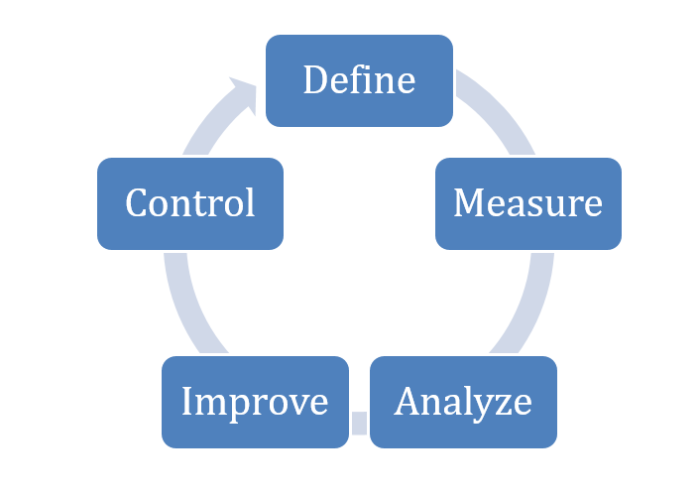
 Data Structure
Data Structure Networking
Networking RDBMS
RDBMS Operating System
Operating System Java
Java MS Excel
MS Excel iOS
iOS HTML
HTML CSS
CSS Android
Android Python
Python C Programming
C Programming C++
C++ C#
C# MongoDB
MongoDB MySQL
MySQL Javascript
Javascript PHP
PHP
- Selected Reading
- UPSC IAS Exams Notes
- Developer's Best Practices
- Questions and Answers
- Effective Resume Writing
- HR Interview Questions
- Computer Glossary
- Who is Who
The Role of Six Sigma in Manufacturing
In today's digital era, one of the most popular process-optimization approaches is Six Sigma. With the key objective of reducing operational waste and redundancies and thus abolishing defects, errors, and waste, it establishes a set of standards for enterprises to adhere to.
The fundamentals of Six Sigma were initially created as a type of quality control, mainly for major manufacturing businesses, with the goal of enhancing performance in the industrial sector. The primary goal of this quality control system was to improve production processes while reducing the number of errors discovered in them. Eventually, the Six Sigma approach was applied globally to different categories of businesses. In this article, you will get to know all about Six Sigma and its role in manufacturing. However, before getting into the details, let's explore what Six Sigma actually means.
What is Six Sigma in Manufacturing?
Six Sigma is a process improvement strategy in manufacturing that aims to reduce waste and create things more effectively. In the 1980s, Six Sigma was developed by Bill Smith, a Motorola engineer. Its name comes from "standard deviation." Six Sigma projects aim to lower variance to the point where errors are measured in parts per million.
Six Sigma and lean manufacturing are frequently closely related in the manufacturing industry. Initiatives like Six Sigma and lean manufacturing aim to increase quality and productivity by getting rid of waste and production errors.
In contrast to lean manufacturing, Six Sigma manufacturing employs a different strategy. Continuous improvement is achieved using a five-step method used in Six Sigma -
Determine value
Map the value stream
Establish a process flow
Set up "pull," i.e., develop an on-demand procedure
Maintaining improvement and perfection
Six Sigma in manufacturing emphasizes the importance of removing variance, which lowers costs and boosts customer satisfaction. With Six Sigma, the customer experience serves as the launching point, and the approach is data-driven.
Six Sigma's Role in Manufacturing
When the Six Sigma approach was developed in the 1980s, Motorola saw a correlation between a drop in manufacturing costs and an improvement in product quality. Up until that point, the conventional wisdom was that higher-quality products cost more to produce. However, it actually proved to be false.
According to the fundamentals of the Six Sigma methodology, an organization's performance is critically dependent on ongoing efforts to establish reliable manufacturing processes. It is crucial to statistically measure the components of these processes so that they may be examined and improved.
Six Sigma-using businesses built their systems and procedures to include quantifiable measurements in their production, customer service, financial, and other activities. They choose the initiatives that best align with their corporate objectives using this method. The company uses the structured Six Sigma method, which is comprised of five steps after defining a project or goal -
Define ? This primary stage involves defining the problem statement, goal statement, project road map, or process flow.
Measure ? In this stage, the company evaluates its current systems to find out, among other things, what might be regarded as a baseline or standard.
Analyze ? In this stage, the system is examined to find solutions to get rid of flaws. The root cause of a problem can be found using a number of methods, including statistical analysis.
Improve ? Project teams look for the best solutions during this phase, then create and test an action plan for enhancing a process or objective.
Control ? In order to aid in preventing future errors, an organization may adjust operational guidelines, rules, or processes on a continuous basis.

Utilizing the Six Sigma Method
When stakeholders identify the metrics that are essential for gauging the success of a manufacturing operation, Six Sigma, a data- and fact-driven management system, may get started. Following an evaluation, a data collection and analysis method should be created and maintained to identify the key elements for enhancing manufacturing process results. Once the procedure is put in place, companies can manage to prevent any possible flaws before they arise.
Six Sigma practitioners in manufacturing receive comprehensive training in the DMAIC approach with the goals of lowering cycle times, eliminating errors, generating cost savings, minimizing variation, and enhancing operational procedures.
Six Sigma's key components in production are as follows -
Focus on how financial objectives are impacted by process improvement, which is related to customer satisfaction.
Each quality characteristic is a unique aspect of the service or product, and both the customer's demands and demonstrable improvements in key procedures are priorities.
Critical internal quality metrics that are related to client demands.
The output value must be greater than the input value utilized for the manufacturer's product to be profitable. The labor, machine, material, and energy inputs that are gathered throughout the Six Sigma transformation are used to produce the output product in accordance with the customer's requirements.
Certification in Six Sigma
The best part of Six Sigma is the availability of several training and certification levels. Like in many martial arts systems, certificate holders are categorized into several "belt" levels; for instance, the first prominent Six Sigma certification is the Six Sigma Green Belt, before which you will also need to complete the programs for white and yellow belts. Six Sigma Black Belts are earned by Masters.
Professionals who have any Six Sigma certification, including a Six Sigma Green Belt, are highly regarded since they can demonstrate their understanding of identifying, measuring, analyzing, improving, and controlling projects. Despite the fact that Six Sigma was first developed as a manufacturing approach, its expansion across sectors has benefited certificate holders because they may use their knowledge in businesses throughout the world.
Conclusion
Six Sigma produces good outcomes in large firms with well-developed management infrastructure and avenues for transparent communication. The majority of businesses that have employed this quality control system to enhance their goods and services belong to the most prosperous businesses in the world.
A specific focus on defining and analyzing the financial rewards of each project is one of Six Sigma's primary characteristics for industrial improvement. All of these aspects enable an organization to precisely define the obligations and functions of each team member in order to enhance the firm's production process.
Making sure that there are as few flaws in the manufacturing process as possible is the main objective of Six Sigma production. The ultimate objective of this system is to have an incidence of 3.4 errors per million probabilities. This may appear to be an impossible endeavor, yet most manufacturing organizations reach this end objective by employing this strategy to make high-quality items.

